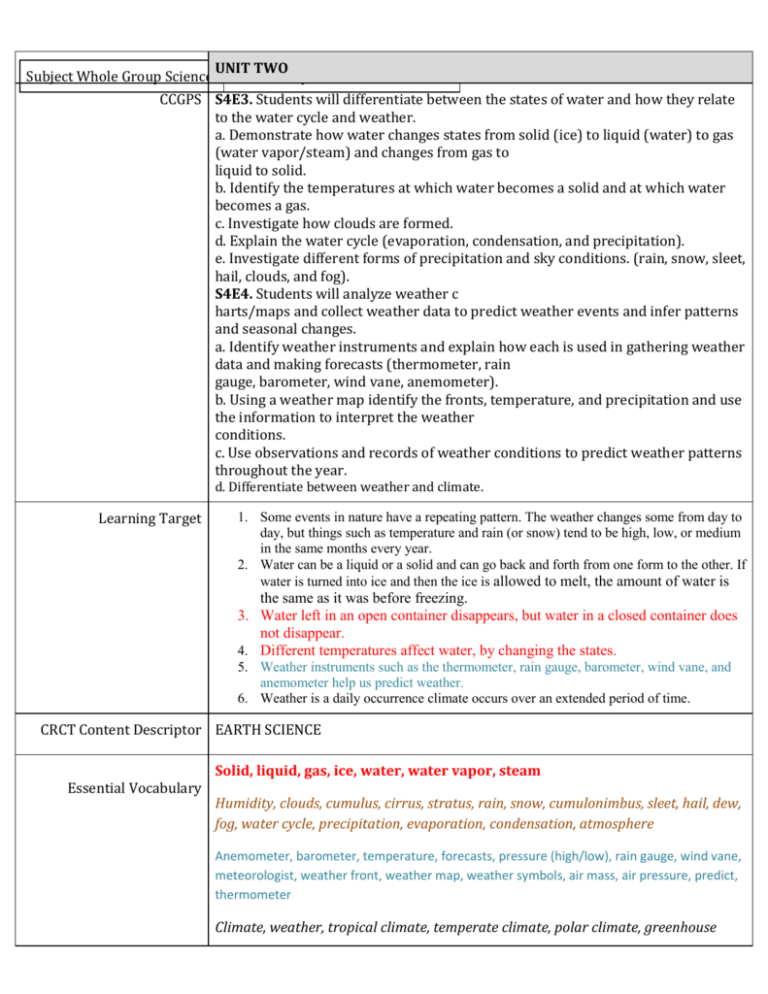SCI_WHOLEGROUP10.6
advertisement

UNIT TWO Subject Whole Group Science: Week of September 29 – October 3 CCGPS S4E3. Students will differentiate between the states of water and how they relate to the water cycle and weather. a. Demonstrate how water changes states from solid (ice) to liquid (water) to gas (water vapor/steam) and changes from gas to liquid to solid. b. Identify the temperatures at which water becomes a solid and at which water becomes a gas. c. Investigate how clouds are formed. d. Explain the water cycle (evaporation, condensation, and precipitation). e. Investigate different forms of precipitation and sky conditions. (rain, snow, sleet, hail, clouds, and fog). S4E4. Students will analyze weather c harts/maps and collect weather data to predict weather events and infer patterns and seasonal changes. a. Identify weather instruments and explain how each is used in gathering weather data and making forecasts (thermometer, rain gauge, barometer, wind vane, anemometer). b. Using a weather map identify the fronts, temperature, and precipitation and use the information to interpret the weather conditions. c. Use observations and records of weather conditions to predict weather patterns throughout the year. d. Differentiate between weather and climate. Learning Target 1. Some events in nature have a repeating pattern. The weather changes some from day to day, but things such as temperature and rain (or snow) tend to be high, low, or medium in the same months every year. 2. Water can be a liquid or a solid and can go back and forth from one form to the other. If water is turned into ice and then the ice is allowed to melt, the amount of water is the same as it was before freezing. 3. Water left in an open container disappears, but water in a closed container does not disappear. 4. Different temperatures affect water, by changing the states. 5. Weather instruments such as the thermometer, rain gauge, barometer, wind vane, and anemometer help us predict weather. 6. Weather is a daily occurrence climate occurs over an extended period of time. CRCT Content Descriptor EARTH SCIENCE Essential Vocabulary Solid, liquid, gas, ice, water, water vapor, steam Humidity, clouds, cumulus, cirrus, stratus, rain, snow, cumulonimbus, sleet, hail, dew, fog, water cycle, precipitation, evaporation, condensation, atmosphere Anemometer, barometer, temperature, forecasts, pressure (high/low), rain gauge, wind vane, meteorologist, weather front, weather map, weather symbols, air mass, air pressure, predict, thermometer Climate, weather, tropical climate, temperate climate, polar climate, greenhouse effect, weather patterns Essential Question(s) 1. What is the difference between weather and climate and how do we describe it? Anchor Charts—What anchor charts will be created or re-visited during instruction? Total Lesson Time Four to five days Teacher Work/ Student Work (x mins) PLEASE BE SPECIFIC. HIGHLIGHT RBIS STRATIGIES: SHOULDER BUDDIES, NONLING.REPRE., SUMMAR.NOTE TAK., SIMILARITIES/DIFFERENCE S, GRAPHIC ORGANIZERS MONDAY Activating Strategy: Teacher will give out the following terms on slips of paper to groups of 3-4 students: 1) calendar, 2) clock, 3) day, 4) month, 5) season, 6) storm, 7) it is hot today, 8) it was a hot summer, 9) it was a rainy day, 10) our summers are usually dry, 11) the wind is blowing hard, 12) we have mild winters. Ask pupils to classify the words and statements into two groups to represent weather and climate (climate words are bolded). Instruction: After discussing which terms are weather and which are climate, collaborative pairs create a generalization about what makes a term fall into the weather or climate category. We should see that TIME is the reason the terms are separated as they are. The shorter time lengths are for weather and the longer times are for climate. Experiment about “How does Climate Change?” Weather and Climate (United Streaming video) Read pages 130-131 Summarize with shoulder buddy what the three types of climates are and how they are different Read pages 132-133 Think-ink-share what factors affect climate Read People in Science page 139 TUESDAY (will go into WEDNESDAY) Students will create a collage of different pictures for each of the different climates—tropical, temperate, and polar. Teacher read aloud “Twister!” pages 136-137 Sticky summary about why weather predictions are important during tornado season Math mini lesson p. 137 about tornado wind speeds Students will read pages 134-135 Make an inference about why meteorologists are concerned about the diagram on the bottom of p. 134 (Antarctica’s more exposed to the Sun’s harmful rays.) Create a climate map for the United States, showing the different climates (tropical, temperate, polar) What can you infer about Georgia’s weather compared to that off California or New York? WEDNESDAY & THURSDAY AP #2: word web listing 3 factors that may lead to climate changes. Wordsplash about “What is the Greenhouse effect?” Who has seen a greenhouse? What does it do for the plants? Collaborative pairs read p. 104-105 Dear Teacher letter about “Why might global warming be a cause for concern?” FRIDAY Teacher facilitates: AP #3: Dear Teacher letter should explain if Earth’s atmosphere gets too warm, it could change the entire balance of life on Earth---every ecosystem would be affected. Lesson Closing Summarizing Strategy (x mins) 1. acrostic for CLIMATE 2. 3-2-1 about 3 things that change climate in an area, 2 differences between tropical and polar climates, 1 friendly definition for Climate HOMEWORK 1. Review and test pp. 140-141 2. Frayer model about climate or weather 3. RAFT as non-native species writing to relatives back home about your vacation to a different climate zone. What was it like, what plants were there, how did it feel, any odd weather you had not experienced before, etc. 4. Dear Teacher letter about Global Warming 5. Workbook pages 80-85 6. Workbook pages 72-79











